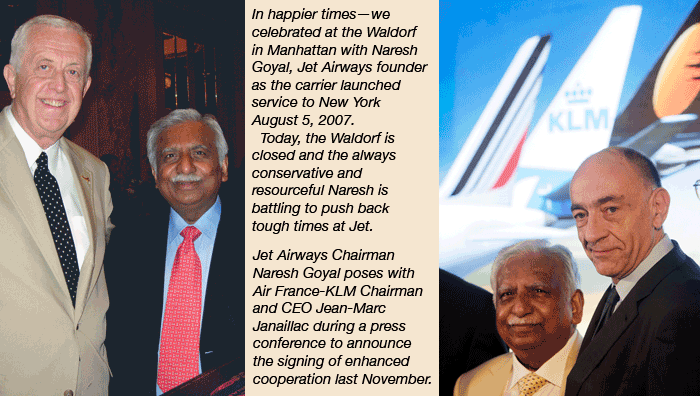
The good news is that the Naresh
Goyal-led Jet Airways is the only carrier from India that
figures among the top 50 world ranking cargo carriers in 2017.
Jet holds 43rd place in international cargo with 885 (FTK million), 23rd
place in domestic cargo with 161(FTK million) and 42nd place overall with
1046 (FTK million).
Now The Bad
News . . .
FlyingTypers has learned that something
might change at Jet in 2018, its 25th year of existence.
 According to several media reports the carrier is facing severe headwinds
and, according to some reports, could not operate beyond 60 more days. According to several media reports the carrier is facing severe headwinds
and, according to some reports, could not operate beyond 60 more days.
Jet Airway’s CEO Vinay Dube
takes an opposite view, stating in a recent press release:
“Jet Airways (India) Limited
would like to clarify that recent media reports about the sustainability
of the airline are not only factually incorrect, but also malicious.
“The airline also denies
any conjecture of a stake sale.”
The statement also mentioned that
“Indian aviation is experiencing strong growth and Jet Airways is
well placed to be a part of this growth story.”
In line with the company's stated
focus of creating a healthier and more resilient business, it has been
implementing several measures to reduce costs as well as realize higher
revenues, for desired business efficiencies.
Dube Dube
Do
Dube also said that despite the
high growth environment, “the aviation industry is currently passing
through a tough phase given a depreciating rupee and the mismatch between
high fuel prices and low fares.
“Jet Airways has been in
existence for over 25 years and through the years has been successful
in combating such business volatility.”
Jet Airways posted a quarterly loss today, its second
consecutive negative financial report.
The airline said that it is adding money (no amount
revealed) and cutting costs aimed at delivering 20 billion rupees
as it seeks to turnaround its business.
Partly (24%) owned by Etihad Airways, Jet operates
in the world’s fastest-growing aviation market, but lost
13.23 billion Indian rupees ($188.76 million) in Q2, the three
months ended June 30.
Speaking of Etihad, the wonder is how does that airline’s
investment model survive after losses it encountered with now
defunct Air Berlin, earlier Alitalia, and now Jet Airways?
Jet blamed the depreciating rupee and an about 36
percent rise in global oil prices for the red ink.
“The two significant proposals . . . infusion
of capital and the monetization of the airline’s stake in
its Loyalty program bode well for the long term financial health
and sustainability of the airline,” assures Jet Airways
Chairman Naresh Goyal.
|
Behind The
Story
While all Indian carriers are going
through tough times, sources say Jet has been pushed into a corner.
The airline had to defer its first-quarter
financial results during its Extraordinary General Meeting (EGM) held
recently in Mumbai to today, August 27.
The results were pushed back “pending
closure of certain matters.”
In fact, sources say Jet’s
financial crisis led to the management deciding on pay cuts of up to 25
percent.
Start &
Stop
However the paycut was rolled back
almost as soon as it was announced, with Goyal saying in a tearful televised
address that he could not sleep thinking about the proposed salary cuts
and hence would cancel such plans.
Severe Cost
Cutting
Nevertheless, Jet Airways has begun
a cost-cutting process by offering pink slips to more than a dozen-odd
technical support staff in Mumbai and Delhi.
The airline has gone on record
to say that it has been evaluating various funding options to meet liquidity
requirements on priority.
Cash Squeeze
But Jet Airways’ lenders
are reluctant to extend additional loans to the cash-strapped airline
ahead of a key report by the company’s financial auditor.
It is not that Jet is not trying
to get back into the game.
 |
Historic
AF/KL Cooperation
At the end of November 2017, for
example, Jet signed a landmark ‘Enhanced Cooperation Agreement’
with Air France-KLM for the development of their operations between Europe
and India. A first in the history of Indian aviation, the agreement strengthens
the partnership built between the three airlines since 2014 and spanned
across code-share agreements as well as cargo between Europe and North
America and Jet Airways’ hubs at Mumbai and Delhi in India via Air
France-KLM’ hubs at Paris-Charles de Gaulle and Amsterdam-Schiphol.
In addition to the airlines’
enhanced cooperation agreement, Air France KLM Cargo and Jet Airways Cargo
also signed a Memorandum of Understanding (MoU) that is aimed to strengthen
their cooperation in the cargo sector.
Cargo Rising
However, if Goyal is forced to
cut corners it will be a pity. In London in November 2017, when the carrier
launched its third daily Boeing 777-300ER flight from Mumbai to Heathrow,
Vinay Dube pointed out how cargo was important for the airline.
He said: “I see air cargo
as an integral part of the business.
“We have got an air cargo
market, which is growing between India and the UK and have a base of cargo
domestically that is growing in India and to the Far East, Middle East
– whereever you look at it. 2017 has been a good year for cargo
and we have seen good growth in many sectors.
“Whenever we think of flying
anywhere, cargo is an important component in the planning process, and
what aircraft you deploy is extremely important as well.”
Dube went on to elaborate that
his cargo team had told him that perishables, pharmaceuticals, manufacturing,
readymade garments, leather products via Paris, London and Amsterdam were
going on to the U.S., Latin America, Benelux, Germany and France.
“Cargo is doing well for
us,” he emphasized and mentioned that the carrier did not have any
plans for freighters because “we are fine with our bellies.”
Tirthankar Ghosh
|




 Vol.
17 No. 51
Vol.
17 No. 51 Vol.
17 No. 52
Vol.
17 No. 52